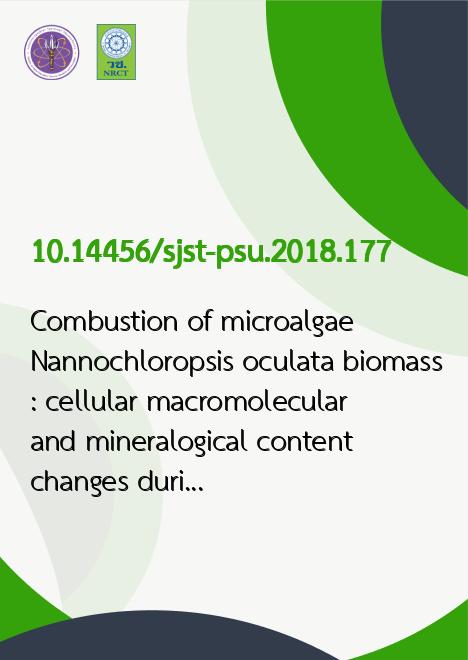
|
Combustion of microalgae Nannochloropsis oculata biomass: cellular macromolecular and mineralogical content changes during thermal decomposition |
|---|---|
| รหัสดีโอไอ | |
| Creator | 1. Sukarni Sukarni 2. Uun Yanuhar 3. I. N. G. Wardana 4. Sudjito Sudjito 5. Nurkholis Hamidi 6. Widya Wijayanti 7. Yusuf Wibisono 8. Sumarli Sumarli 9. I. M. Nauri 10. Heru Suryanto |
| Title | Combustion of microalgae Nannochloropsis oculata biomass: cellular macromolecular and mineralogical content changes during thermal decomposition |
| Publisher | Research and Development Office, Prince of Songkla University |
| Publication Year | 2561 |
| Journal Title | Songklanakarin Journal of Science and Technology |
| Journal Vol. | 40 |
| Journal No. | 6 |
| Page no. | 1456-1463 |
| Keyword | combustion, microalgae, Nannochloropsis oculata, cellular macromolecular, mineralogical content |
| URL Website | http://rdo.psu.ac.th/sjstweb/index.php |
| ISSN | 0125-3395 |
| Abstract | The cellular macromolecular and mineralogical content changes during the combustion of Nannochloropsis oculata biomass have been investigated. A Fourier transform infrared spectroscopy (FTIR) analyzer was used to investigate the cellular macromolecular content changes of biomass at every stage of decomposition during heating to 1200 ?C. From ambient temperatures to 190 ?C, similar spectra were obtained, indicating relatively little change in the chemical structure of the biomass material. Changes in the spectra are very noticeable from 190 to 1200 ?C. The combustion process begins with thermal cracking of the ?OH groups of silanol that escape together with moisture at temperatures up to 190 ?C. Subsequent temperature increase decreased intensity of the spectrum, indicating thermal degradation of the organic compounds derived from lipids, proteins, and carbohydrates. These processes occur up to 800 ?C. The X-ray diffraction (XRD) results showed that the mineral constituents of biomass degraded during the combustion process, and a portion reacted to form new compounds such as melilite (Ca6Na2O15Si4). The SEM images show a morphological distinction between biomass and its residue at 1200 ?C, due to the decomposition and rearrangement of the mineral content during heating. Fragmentation of the samples also occurred during heating, characterized by more uniform residue at 1200 ?C. |
